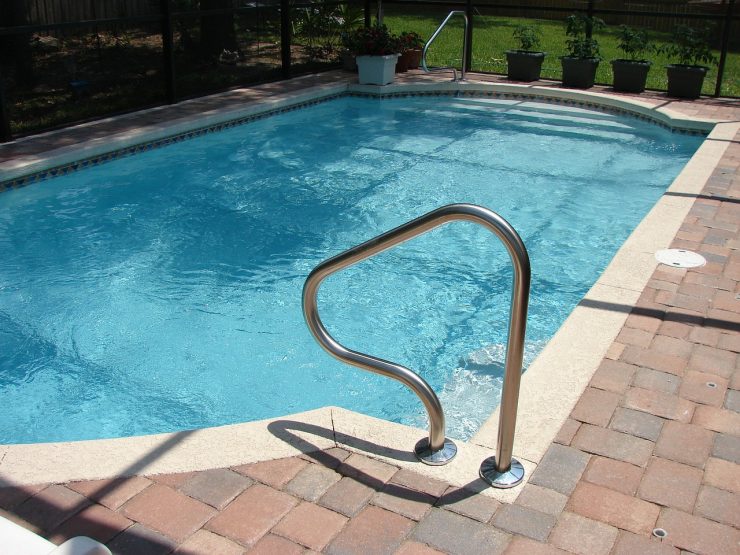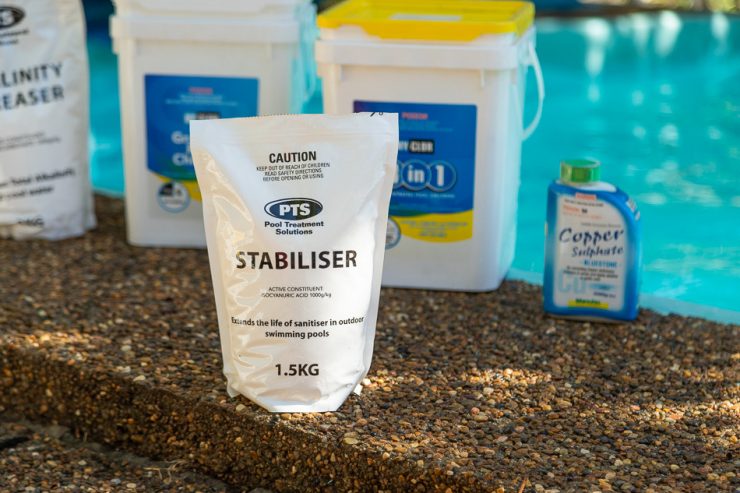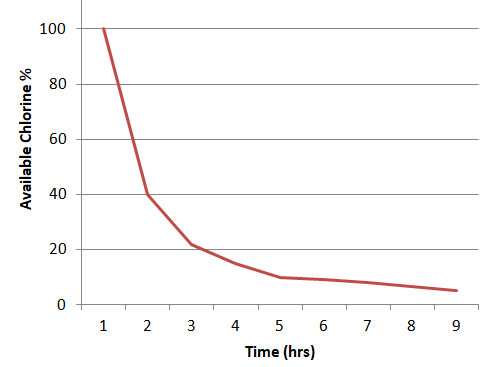Unsure if you can use a stabilizer in your saltwater pool? Understanding how best to use a stabilizer in your saltwater pool is crucial for a healthy pool.
You can use cyanuric acid (stabilizer) in your saltwater pool just like with chlorine pools. Saltwater pools generate chlorine so this chlorine also needs stabilizer to protect it from the Sun’s UV rays. Luckily, the steps to stabilize a saltwater pool are very similar to a chlorine pool.
However, there are a few things to know when dealing with cyanuric acid and saltwater pools.

Article Contents
What is Stabilizer (Cyanuric Acid)?
Adding stabilizer, otherwise known as cyanuric acid (or sunscreen for your pool), to your salt water pool helps retain the chlorine level (1-5 ppm). This is especially important in outdoor pools as it’s under direct contact with the sun.
Why is stabilizer in a saltwater pool important? The sun emits UV rays, which destroys the free chlorine in the pool. If the chlorine levels of your pool drop below 1-3 ppm (parts per million), your pool will not sanitize itself properly. This will leave room for bacteria and algae to grow, resulting in the increase of infection and the pool filter clogging up.

Cyanuric acid works by binding with this free chlorine to protect it. It does this without interfering with the effectiveness of the chlorine sanitizing the pool. This leaves the free chlorine available to float around the pool and work against harmful bacteria.
Some types of pool chlorine has stabilizer included in it. For example, dichlor or trichlor tablets. However, if you’re using liquid chlorine, bleach or calcium hypochlorite, it won’t contain cyanuric acid, so you’ll need to add it separately.
Do You Need Stabilizer in A Saltwater Pool?
Using a stabilizer is just as crucial for a saltwater pool as it is for a chlorine pool. If not even more so. In chlorine pools, pool owners often use chlorine which already contains a stabilizer. This reduces the need to add stabilizer separately.
But with saltwater pools, the saltwater generator makes unstabilized chlorine. This chlorine is not protected from the sun. Therefore, it is more easily burnt off by the sun’s rays. Studies have found that chlorine levels reduced by 90% within just 2 hours of sunlight.

Manufacturers of saltwater generators such as Hayward and Pentair recommend adding more stabilizer than you would with a chlorine pool. It’s important to keep the cyanuric acid level between 30-60 ppm
The exact level of stabilizer you add will depend on the chlorine amount. More on that later.
What Does Stabilizer Do for Saltwater Pools?
Saltwater pools sanitize themselves by generating free chlorine. They do this by converting salt (sodium chloride) into sodium ions and chlorine ions by electrolysis. These free chlorine ions bind with bacteria and chemicals and filter out of the pool. The excess chlorine rejoins with the sodium before returning to the saltwater generator.
Having stabilizer in the water of your saltwater pool means the chlorine will last much longer and your saltwater chlorine generator (SWG) won’t need to work as hard.
Salt cells have a lifespan of about 5-7 years but usually need replacing around the 3-5 year mark. This timeframe would be even less if there’s an insufficient amount of stabilizer in your pool.
When to Add Stabilizer In Saltwater Pools
Before you add any more stabilizer to your saltwater pool, it’s important that you’ve checked the stabilizer/cyanuric acid (CYA) levels and chlorine levels. Saltwater pools can often be kept at a higher level of CYA than a typical chlorine pool.
If your saltwater pool’s cyanuric acid drops below 30-60 ppm, there may not be enough stabilizer in the pool to prevent the chlorine from burning off from the sun. The longer it takes to fix this problem, the harder the salt cell has to work to generate enough chlorine. And the more risk of algae and other bacterial and virus outbreaks.
Regularly testing your pool’s water chemistry is crucial to maintaining a clean and safe pool to swim in. Test strips are simple to find and most pool stores will carry them.
The AquaChek 7-Way Pool and Spa Test Strips are a firm favorite among pool owners. These strips have a rating of 4.7 stars out of 8,551 Amazon reviews. They test the 7 most water chemistry important levels, including cyanuric acid. Unfortunately, some reviewers noticed inaccuracies with their results compared with other branded test strips.
- 7-in-1 Test: pH, chlorine, bromine, cyanuric acid & more
- For pools and spas
- Quick and easy
A more accurate way to test the stabilizer levels of your pool is with a drop kit. Taylor is well know for producing accurate test kits and they are the choice of many pool professionals.
Check out the Taylor saltwater test kit here >>
- For saltwater pools
- Extremely accurate
- Tests 7 things including salt, pH, chlorine, cyanuric acid
A word of caution on when you’re testing your pool. If you’ve just opened your pool for the season, let the pool circulate for 3-5 days before testing the CYA level. Cyanuric acid is denser than water so will settle to the bottom of the pool when the filtration system is off.
Saltwater Pool Stabilizer Options
Now that you have an understanding of the importance of using stabilizers in your saltwater pools, it’s time to consider what types you can use for your pool. Is there any difference in using one typically designed for a chlorine pool? Are there safe alternatives to use in saltwater pools? Let’s see.
Can You Use Baking Soda as A Stabilizer?
It might be a bit weird to think that a key ingredient for perfectly baked cakes and loaves of bread is applicable to your pool too. But, baking soda is a cost-effective alternative to balance the pH and alkalinity levels when they’re too low in your pool.
However, baking soda is not a stabilizer and you shouldn’t use it as one. It won’t have any effect on keeping the sun from burning off the chlorine.
Is Shock the Same As Stabilizer?
Simply put, shock is not the same as stabilizer. Pool shock is a high dose of chlorine that dramatically increases the level of free chlorine in your pool. Ideally, you can use it to rid your pool of large amounts of contaminants like algae blooms. Or after heavy use of your pool. Some pool owners even include it into their pool maintenance, shocking every 1-2 weeks.
Stabilizer is a different chemical composition to shock and they are not interchangeable.
Want to become a pro at shocking your pool? Check out our article: How to Shock Saltwater Pool | And How Often to Shock It
What Alternative Stabilizer Can I Use?
There are no good alternatives to using cyanuric acid to stabilize your pool’s chlorine.
Luckily, there are plenty of quality chlorine stabilizers on the market including Clorox’s Pool & Spa Chlorine Stabilizer.
- Stabilizer aka cyanuric acid
- Helps make chlorine last longer
- For salt or chlorine pools
Clorox is a popular brand for bleach and you can see this in their Amazon rating. This stabilizer has 4.7 stars out of 4,076 reviews. It’s ideal for saltwater pools and comes with an app to help monitor your pool’s chemistry levels.
The main issue some pool owners found was that they found it hard to dissolve it into the water. If you’re having trouble dissolving stabilizer in your pool, check out our article: How to Dissolve Pool Stabilizer | Stabilizer Not Dissolving
How To Raise Stabilizer In Saltwater Pool
Before raising the stabilizer/cyanuric acid level of your pool, it’s important to follow these steps to keep yourself and your pool protected.
- Get protective gear and clothing
- Test the pool for current water chemistry levels
- Calculate pool volume
Safety First
Firstly, when you’re dealing with any chemicals, it’s important to keep yourself protected. Cyanuric acid can burn the skin and eyes, so make sure to follow the guidelines given by the stabilizer manufacturer is key to a safe application for yourself and your pool.
Wearing goggles, gloves, and protective clothing is ideal. The clothing doesn’t need to be anything special but should cover your arms and legs.
Retest the Water
Next thing is to test the pool for the current pool level just before adding the cyanuric acid. Getting a reading just before adding cyanuric acid will give you the most up-to-date and accurate state of your pool’s chemistry.
Calculate Pool Volume
Calculating your pool size, by the gallon, can be awkward especially if it is an irregular shape. However, your pool’s manufacturer should have the volume listed in their paperwork. If not, you’ll need to do some math.
| Pool Shape | Formula Needed |
| Rectangular | width x length x depth x 7.48 gal (28.3 L) |
| Circular | π x radius2 x depth x 7.48 gal (28.3 L) |
| Oval | π x ½ width x ½ length x depth x 7.48 gal (28.3 L) |
| Variable Depth | Find the average depth: shallow end depth x deep end depth ÷ 2. Use this depth when using other formulas. |
| Irregularly Shaped | Calculate each section using the other formulas and add them together. |
Once you’ve found the volume you can now figure out how much stabilizer you need.
How Much Stabilizer Do I Need for a Saltwater Pool?
Determining how much cyanuric acid you’ll need depends on a few factors. These include:
- the current CYA ppm level
- the desired level
- the volume of your pool
- the chlorine level
Stabilizer Level Affects Chlorine Needed
One thing that hasn’t really been taken into account until recently is that the level of stabilizer in the water affects how much chlorine you’ll need. You see, as the stabilizer level rises, more chlorine is needed to do the same job. Chlorine needs to be 7.5% of the stabilizer levels.
E.g. If you have 50 ppm of stabilizer in the water, you will need a minimum of 3.75 ppm of free chlorine for effective sanitization. i.e. 50 ppm stabilizer x 7.5% = 3.75 ppm of chlorine.
That’s why it’s best not to raise your stabilizer levels too high. You’ll need more chlorine than the saltwater generator can produce.
How Much Stabilizer to Add
The chart below features some of the most common pool sizes dealing with the same current and desired CYA levels (50 ppm and 70 ppm, respectively). And how much you need to add to balance the levels.
| Pool Size | Granular Stabilizer Needed | Liquid Stabilizer Needed |
| 3,000 gal (14,547 L) | 4 oz (0.24 Kg) | 10 oz |
| 10,000 gal (45,461 L) | 27 oz (0.77 Kg) | |
| 15,000 (66,827 L) | 39 oz (1.1 Kg) | |
| 25,000 (109,106 L) | 64 oz (1.8 Kg) |
It’s important to decide which stabilizer you will be using as the amount of stabilizer depends on the type. As well as depending on your pool size. This handy calculator is customizable to your saltwater pool’s specific needs.
Make sure to follow the instructions of the stabilizer on how to apply it correctly to your pool.
How To Lower Stabilizer In Saltwater Pool
For whatever reason it may be, you’ve accidentally added too much stabilizer to your saltwater pool. Unfortunately, cyanuric acid doesn’t evaporate into the atmosphere. It will stay in the water.
When there is too much stabilizer, it reduces the efficiency of the chlorine. Therefore, this will leave your pool vulnerable to the build-up of bacteria and the development of algae blooms. The only effective solution to fixing this is to dilute the stabilizer.
You can do this by partially draining and then refilling your pool with fresh water. You’ll need to add the chemicals needed to rebalance the pool’s chemistry after you top up the water.
Want to know how exactly to lower stabilizer in your pool? Check out our article: How to Lower Cyanuric Acid in Pool (Cyanuric Acid Too High)
Can You Add Salt And Stabilizer At The Same Time?
Salt and cyanuric acid do not interact with each other. Therefore, it is safe to add them to the pool at the same time. This can help with making your pool routine less effort and time-consuming.
Final Thoughts
As you can see, stabilizing your saltwater pool is just as important as if you had a chlorine pool. Luckily, the steps to stabilize it are very similar to the more common pool type.
With this guide, you’ll be confident in your knowledge of maintaining a happy and healthy saltwater pool.
Related Reading: Hot Tub Cyanuric Acid (Stabilizer) High | How to Lower




